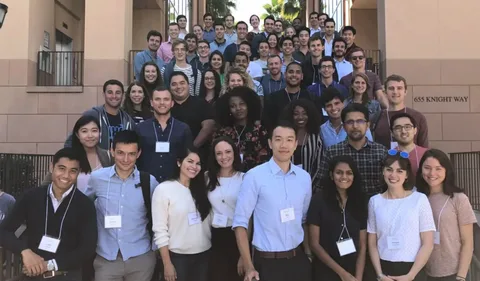The High Stakes of MBA Financing
Pursuing an MBA at a top-tier institution like the Wharton School is more than an educational decision—it’s a life-changing investment. For the Class of 2026, the total cost of attendance at Wharton, covering tuition, fees, and living expenses, hovers around $132,224 per year, culminating in roughly $264,448 over two years (MBA Guide Consulting). While the long-term return on investment (ROI) is compelling—Wharton graduates command median starting salaries exceeding $165,000—upfront costs can become a formidable barrier.

Enter the Wharton MBA Fellowship, a merit-based grant designed to defray tuition and fees, unlocking access for exceptional leaders regardless of their financial background. In this guide, we’ll demystify the fellowship landscape, show you how to “Master Your MBA Funding,” drill into the specifics of the “Wharton MBA Fellowship 2026,” and offer actionable strategies to “Secure Your $100K+ Grant.”
Master Your MBA Funding: Understanding Wharton’s Fellowship Framework
Every student admitted to Wharton is automatically considered for a fellowship—no separate application required (MBA Inside). The Wharton Fellowship Program offers two-year awards, divided equally over four semesters, and can be applied toward tuition and mandatory fees. Here’s how it works:
- Automatic Consideration
- By simply submitting a strong MBA application—GMAT/GRE scores, transcripts, essays, and recommendations—you enter the fellowship pool.
- Selection Criteria
- A holistic review: unique personal qualities, academic achievement, professional development, and community involvement.
- Award Structure
- Two-year total, split equally across fall and spring terms.
- Fellowships stack with external scholarships up to tuition costs; excess external funding reduces Wharton fellowship awards.
- Renewal contingent on maintaining good academic standing in Year 1.
Pro Tip: Veterans can leverage Wharton merit-based funding up to the full Cost of Attendance, maximizing support for U.S. military service members (MBA Inside).
Wharton MBA Fellowship 2026: Key Highlights and Updates
As applications for the Class of 2026 open, here’s what every prospective candidate needs to know:
- Range of Awards: Fellowship amounts vary widely—from partial tuition offsets (~$25,000 per year) to named fellowships exceeding $100,000 over two years. In recent cycles, recipients have seen awards anywhere between $50,000 and $140,000 total, with notable stories of mid-semester enhancements (e.g., up-next named fellowship bumped from $50K to $90K) (Reddit).
- Named Fellowships:
- Joseph Wharton Fellowship – Honors the School’s founder; strong leadership and community service background favored.
- Prism Fellowship – Full tuition for LGBTQIA+ advocates, typically one cohort member per year.
- Helen M. Schepps Fellowship, Forté Foundation Fellowship (women’s leadership), and more.
- Second-Year Top-Up Awards: New or supplemental fellowships for high-achieving second-year students, determined by renewed application and existing financial support.
Comparing Fellowship Generosity: Wharton vs. Other M7 Programs
To gauge your competitive positioning, it helps to compare Wharton’s fellowships with similar offerings at peer schools:
| School | Avg. Award (2 Years) | % Students Awarded | Max Award (2 Years) |
|---|---|---|---|
| Wharton School | $75,000 (est.) | 30–40% (est.) | $140,000+ |
| Harvard Business School (need-based) | $92,000 | 50% | Full tuition (~$150K) (Harvard Business School, Harvard Business School) |
| Stanford GSB (need-based only) | $88,000 | 50% | Full tuition (~$160K) (Poets&Quants) |
| Chicago Booth (merit & need) | $80,000 (est.) | 40% | $120,000 |
| Columbia Business School | $50,000 | 30% | $100,000 |
| MIT Sloan (merit & need) | $80,000 (est.) | 35% | $120,000 |
Insight: Wharton’s fellowship share and award range are highly competitive among M7 schools. While Harvard and Stanford emphasize need-based aid, Wharton’s merit-driven model often yields larger single awards for standout profiles.
The Dynamics of MBA Funding: Merit vs. Need
Merit-Based Fellowships
- Wharton Model: Awards based on academic track record, leadership, and professional accomplishments—no need assessment required.
- Advantages: You don’t reveal personal finances; high achievers can secure substantial awards.
- Considerations: Fellowship levels vary widely; exceptional essays and recommendations are critical.
Need-Based Scholarships
- Harvard & Stanford: Focus on demonstrated financial need, with standardized formulas factoring income, assets, and dependents.
- Advantages: Transparent assessment; up to full tuition for high-need candidates.
- Considerations: Requires full financial disclosure; maximum awards reserved for greatest need.
Hybrid Strategies
- Secure merit-based awards first, then explore need-based or external support to cover any remaining gap.
- Employers, government programs (e.g., Fulbright, LPDP), and professional associations (Forté Foundation, The Consortium) offer valuable supplements.
Crafting a Fellowship-Winning Application
1. Showcase Authentic Leadership
- Narrative: Tell a cohesive story of impact—whether you led pro-bono consulting projects, founded nonprofits, or spearheaded change initiatives.
- Evidence: Quantifiable outcomes (e.g., “Raised $50,000 to expand a youth entrepreneurship program impacting 500 students”).
2. Demonstrate Academic Rigor
- Scores & Transcripts: A stellar GMAT/GRE (target ≥ 730) and a strong GPA (≥ 3.6) position you favorably (MBA Guide Consulting).
- Coursework & Certifications: Highlight advanced courses or certifications relevant to your career goals (e.g., financial modeling, data analytics).
3. Leverage Community Involvement
- Depth over Breadth: Long-term commitment (e.g., years as a volunteer tutor, community board member) often outweighs one-off events.
- Leadership Roles: Board positions, committee chairs, or founding new initiatives showcase sustained engagement.
4. Secure Powerful Recommendations
- Champions, Not Bystanders: Choose recommenders who can speak in detail about your leadership and professional growth.
- Preparation: Provide recommenders with bullet-pointed achievements and discuss your MBA objectives.
5. Target Named Fellowships
- Alignment: If you identify as a woman leader, candidate from an MENA country, LGBTQIA+, or veteran, explicitly connect your background to specific named awards (e.g., Forté Foundation, Prism Fellowship, Israeli Service Fellowship).
External Fellowships & Sponsorships: Amplify Your Funding
Beyond Wharton’s internal pool, dozens of external fellowships can bolster your MBA budget:
- Forté Foundation Fellowship: $15,000–$25,000 for women at partner schools (includes Wharton).
- Reaching Out LGBTQ MBA Fellowship: Up to $28,000, plus leadership retreats.
- The Consortium for Graduate Study in Management: $10,000–$20,000 for underrepresented minorities.
- Government Scholarships: Fulbright (U.S.), Chevening (UK), LPDP (Indonesia), etc.
Strategy Tip: List every eligible external opportunity, calendar deadlines, and apply by your Round 1/2 MBA timeline to maximize stacking options.
Navigating Corporate Sponsorships and Loan Strategies
Corporate Sponsorships
- Top Sponsors: McKinsey, Bain, BCG, Deloitte, Wells Fargo, Apple, Intel.
- Negotiation Leverage: Demonstrate your firm’s ROI on your post-MBA impact; align your MBA goals with corporate strategy.
- Contract Clarity: Confirm whether sponsorship is a grant, loan, or contingent on post-MBA employment.
Loans & Repayment Support
- Federal Loans (U.S. citizens): Stafford, Grad PLUS—lower interest and deferred payment options.
- Private Loans: Shop rates and terms carefully; some offer rate reductions for auto-pay.
- Loan Forgiveness Programs: Public Service Loan Forgiveness (PSLF) for qualifying nonprofit/government careers.
Table: MBA Funding Options at a Glance
| Funding Source | Amount Range | Eligibility | Application Deadline |
|---|---|---|---|
| Wharton Fellowship | $12,500–$140,000 total | Automatic with MBA application | Rolling (with admission) |
| Forté Foundation Fellowship | $15,000–$25,000 total | Women, partner schools | Varies (apply early fall) |
| Reaching Out LGBTQ MBA Fellowship | Up to $28,000 | LGBTQI A+ students | January 2025 |
| The Consortium Fellowship | $10,000–$20,000 total | Underrepresented minorities | September 2025 |
| Corporate Sponsorship | Variable | Employer agreement | Company timeline |
| Fulbright Scholarship | $20,000–$50,000+ | U.S. citizens for international study | October 2025 |
| Grad PLUS Loans | Up to COA | U.S. citizens/permanent residents | Align with MBA admission |
| Private Loan (e.g., Sallie Mae) | Variable | Credit-based | Rolling |
| PSLF (Loan Forgiveness) | N/A (post-MBA) | Public/nonprofit careers | N/A |
Key Insights and Implications
- Merit vs. Need: Your Best Route
- If you possess an outstanding professional record and strong test scores, prioritize Wharton’s merit-based fellowships and external awards.
- If financial need is significant, explore supplementary need-based programs like Harvard’s model or governmental funding.
- Stacking for Success
- There’s no one-size-fits-all: combine internal fellowships (Wharton), external grants (Forté, Consortium), corporate sponsorships, and strategic loans.
- Timing Is Everything
- Begin research 12–18 months before Round 1 deadlines.
- Track each opportunity’s timeline in a shared spreadsheet, ensuring no missed deadlines.
- ROI Focus
- Evaluate funding offers not just by headline award, but by how they position you for summer internships, second-year academic projects, and career placement support.
- Negotiation Leverage
- Use competing offers (scholarship or admission) to negotiate larger awards; Wharton does not reconsider initial fellowships, but external sponsors may flex.
Conclusion: Your Roadmap to a $100K+ Grant
Securing over $100,000 in fellowship support for your Wharton MBA is an ambitious yet achievable goal—provided you enter the process well-prepared and informed. By:
- Mastering Your MBA Funding through disciplined research and calendaring,
- Understanding the Wharton MBA Fellowship 2026 landscape and its named awards,
- Actively stacking external fellowships, corporate sponsorships, and smart loan strategies,
you position yourself to transform a daunting price tag into a manageable—and even enriching—financial journey.
Remember: your fellowship profile starts with a compelling personal narrative, backed by quantifiable achievements and recommendations that resonate with selection committees. Couple that with strategic engagement of external and employer scholarships, and you’re well on your way to securing a $100K+ grant that fuels not just your MBA, but the career impact you aspire to make.
Start planning today, strategize your applications with clear goals, and let the Wharton MBA Fellowship be the cornerstone of your next chapter. Good luck!

